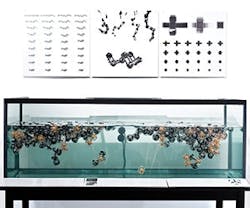There are certain fundamental truths about science and learning. One is that the more you know, the more you come to realize what you don't know. Another is that even once you've learned something in the course of your testing or problem solving, sometimes a better idea can present itself, and you have to remain open to that possibility.
Interior design is a perfect example of this sort of constantly evolving science. The way we approach our practice clearly illustrates that. We start with a design problem or need, and develop hypothetical solutions. We experiment, make observations and predictions, and follow up with testable explanations until we arrive at what we know to be the best solution that our imagination, expertise, and skill will afford. And we have to remain open to the possibility that through a combination of thorough research and ingenuity, someone else may think of another equally or more effective solution.
I've written in this space previously about the importance of evidence-based design (EBD; see "5 Qualities of Design Mastery" in the January 2013 issue), but it's worth reiterating that this practice approach, which began with a healthcare focus, is now permeating all fields of design. Why? Because as interior designers, we are accountable for every aspect of the lives of the people inhabiting the spaces we design. Their health, safety, welfare, productivity, community, and happiness are all thoroughly dependent on the decisions we make regarding the built environment. As such, it makes absolute sense to base those decisions on credible research to produce results that are optimal and quantifiable.
This is why IIDA has made a commitment to bringing research to the forefront of its focus, most recently launching a partnership with the Business and Institutional Furniture Manufacturers Association (BIFMA) on a joint research study to determine measurable indices for workplace design—a clear illustration of our ongoing commitment to furthering the cause of evidence-based design.
And yet, even as EBD continues to influence and elevate the standards of our practice, science presents new and unexpected ways of considering design. I recently had the pleasure of attending a presentation by MIT's Self-Assembly Lab director, Skylar Tibbits. Self-assembly, in brief, is defined as a process in which disordered parts can be ordered to form an organized, cohesive structure through local interaction. It's a new, exciting, and complex means through which to explore design solutions, and I have to admit that Tibbits' concepts for discussion, which involved innovations in self-assembly and 4-D printing were new to me—I'm just beginning to grasp 3-D printing—but the implications of the lab's work are huge. They are poised to profoundly impact nearly every aspect of the design practice, from construction and manufacture to product assembly and performance, as well as how we design products and order space.
In recent years, Tibbits has been collaborating with designer Marc Fornes of THEVERYMANY—who recently served on the judging panel for the IIDA Global Excellence Awards—to develop entirely new programming techniques and software that enable them to create wildly organic forms that have been captivating onlookers from New York to Poland. (Visit bit.ly/MoMAelastic for a look at their online MoMA exhibition, "Design and the Elastic Mind.")
Tibbits' and Fornes' work and the direction it points capture an interesting moment in design. Even as EBD continues to progress and make inroads into the various design disciplines, other, radically different design solutions are being explored, discovered, and considered for the vibrant innovation they offer. This speaks to the strength that flux can bring to our industry, and how a brilliant idea can inspire others to improve upon methods that we know to be solid and trustworthy. It also speaks to how complex the nature of the design process really is, and how big a role science has to play in it.
Being open to new and different solutions is an imperative in our profession, and one that underscores the need for constant awareness and a full understanding of the complexities of the industry. For example, that means understanding the composition of the materials in the products that we specify, even when going through everything it takes to have a complete grasp on the details can make it seem like we're in a chemistry class. All of us who have done that research know that feeling. But it's our responsibility to know what is in those materials and how they'll be maintained. To that end, IIDA supports the development of the Health Product Declaration (HPD), which encourages manufacturers to fully disclose the materials used in their products, in much the same way that the Food and Drug Administration requires ingredients to be listed on packaged foods.
But even armed with that information, we still only have part of the picture, since the interaction of certain "acceptable" chemicals can yield an unacceptable result. There's always something more to know, to research, and this is why it's so crucial for us to pay heed to the science of design—to be ever-vigilant, open to new solutions, and perhaps most of all, to remain curious about bettering ourselves and our practice through science, and any other means available to us.
IIDA President Felice L. Silverman, IIDA is president and a principal at Silverman Trykowski Associates Inc. in Boston. You can reach IIDA at (312) 467-1950 or at [email protected].
